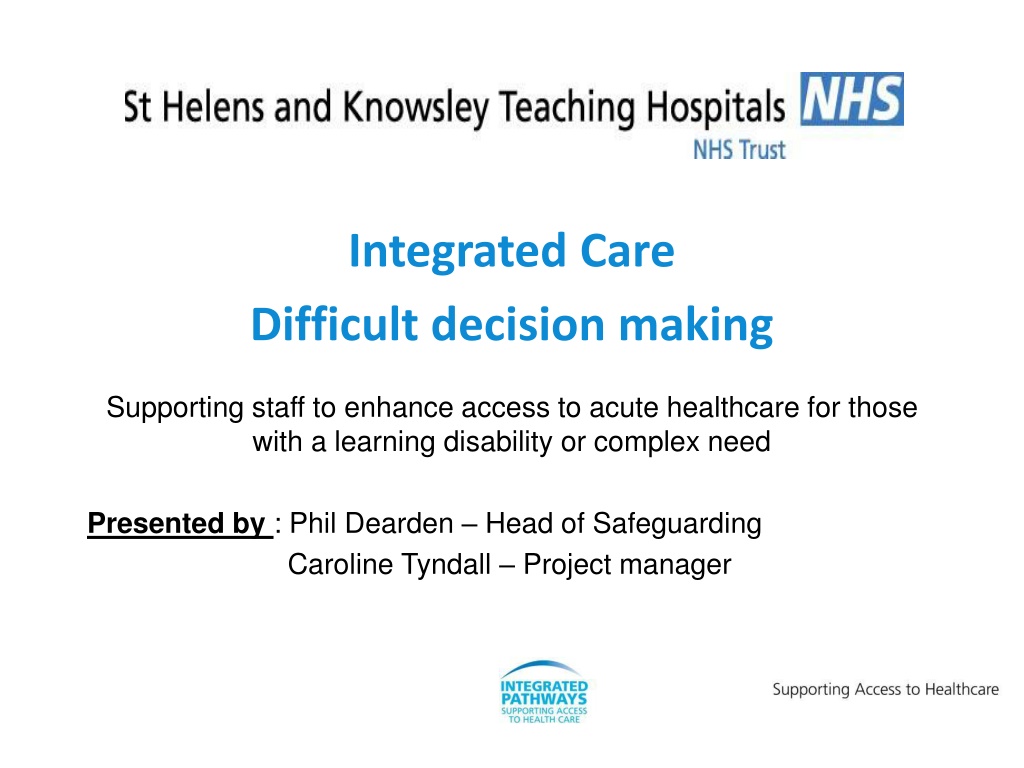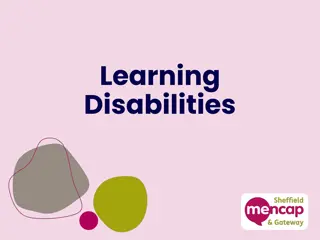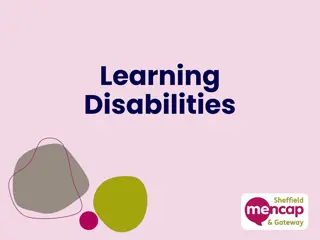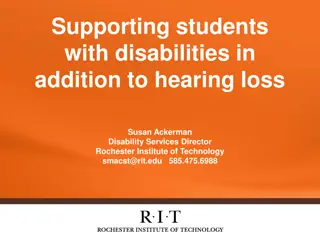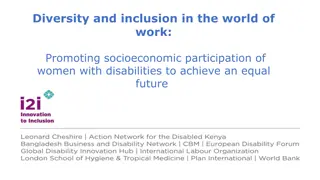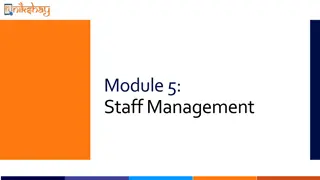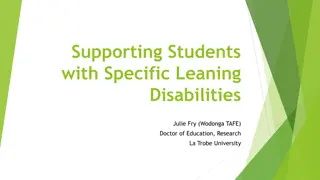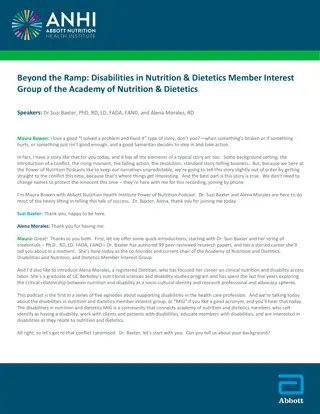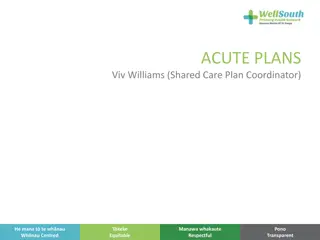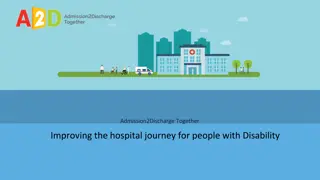Enhancing Access to Acute Healthcare for Individuals with Learning Disabilities: Supporting Staff in Difficult Decision-Making
Presented by Phil Dearden and Caroline Tyndall, this presentation addresses the challenges in providing acute healthcare for individuals with learning disabilities. It highlights reports on inequalities, observations on healthcare access, obstacles faced, existing good practices, and what good healthcare should entail.
Download Presentation

Please find below an Image/Link to download the presentation.
The content on the website is provided AS IS for your information and personal use only. It may not be sold, licensed, or shared on other websites without obtaining consent from the author. Download presentation by click this link. If you encounter any issues during the download, it is possible that the publisher has removed the file from their server.
E N D
Presentation Transcript
Integrated Care Difficult decision making Supporting staff to enhance access to acute healthcare for those with a learning disability or complex need Presented by : Phil Dearden Head of Safeguarding Caroline Tyndall Project manager
Major reports highlighting inequalities Treat Me Right, 2004 Death by Indifference, 2007 Healthcare For All, the Michael report 2008 Getting it Right, 2010 Death by Indifference: 74 deaths and counting,2012 CIPOLD report findings and recommendations, 2013 Premature deaths of people with learning disabilities DOH progress update 2014 And yet, an estimated 12,000 people with a learning disability died prematurely between 2004 and 2014 * (Figures estimated from scaling up Glover and Emerson, 2013)
Healthcare for all observations Recognising inequalities in access does not require specialist knowledge in learning disabilities Equal does not always mean the same Reasonable adjustments are not particularly difficult Good practice exists and needs to spread
Obstacles to acute healthcare access Communication difficulties Awareness of available services Lack of understanding of the consequences of not attending for investigations or screening programmes Diagnostic overshadowing symptoms attributed to learning disability characteristics Lack of awareness healthcare professionals
Existing good practice at STHK Reasonable adjustments e.g. 1. 2. 3. 4. Use of Hospital Passport Accessible information - Easy-read letters and information Electronic flagging on IT systems Changing Places bathroom under construction Learning disability care pathways in various specialties e.g. endoscopy, radiology, elective surgery, specialist dentistry Excellent links to local learning disability nurse teams, providing advice and guidance
Key elements for all Relationship formation and information sharing Provision of accessible information method of communication Reasonable adjustments requirements Links to professionals/tools to support Establishing capacity to consent Best interests decision making confidence in planning and implementation of least restrictive option for the individual
Developing the pathway Establish steering group and TOR Liaison with governance councils to set scene Recruit project manager and admin support Literature search and contact with acute trusts establishing what good looks like Meet with all stakeholders actual and virtual First draft of pathway and feedback Questionnaire drafted and circulated Accompanying toolkit constructed Final draft recruitment of design group Completed product ready for Trust roll-out
Pathway point 1 GP consultation and referral Reasonable adjustments to consider Timing of appointment first or last one of the day? Double slot to allow more time for discussion? Communication always talk directly to the patient first, then to any carer present. Listen to the carer s observations of changes in behaviour are these expressions of pain and discomfort? Use simple language/no jargon or communication tools to explain proposed investigations/treatment. Use easy-read leaflets/documentation to assist this process (easyhealth.org.uk has helpful materials available for use) Health promotion has the patient and their carer completed a Health Passport document? Do they need assistance to do this or update an existing one? Are they known to the community learning disability team? Do they need referring? Has a health action plan been offered and an annual health check been booked? Other professionals who can help Community learning disability team can offer support and guidance to a person with a learning disability and their family/carers e.g. assistance in completing or updating a Health Passport/Health Action Plan, involvement in best interests decision making process for those who lack capacity to consent to specific investigations or treatment. Best interests decision making Does the patient lack capacity to consent to a particular investigation or proposed treatment? See Appendix 1 to guide you in establishing this. Does the patient already have a lasting power of attorney in place for healthcare decisions? If the patient is deemed to lack capacity, how can the best interests of the patient be established regarding the proposed investigation/treatment? See Appendices 1 and 2 to support you in this process.
Reasonable adjustments to consider Discharge planning ensure discharge planning commences on admission of the patient. Establish whether a referral to the Integrated Discharge Team (IDT) is required to assist in facilitating the patient s discharge or to contact the social worker in the community that is already involved with the patient and therefore aware of their care provision needs at home. Ensure the patient s discharge is as timely as possible, reducing any anxiety/distress caused by the unfamiliar environment of the ward. Ensure all equipment/supplies required are identified and provided prior to the day of discharge. Ask the pharmacist to review medication and their method of administration prior to discharge. Communication meet with the patient and their family/carers as early in the patient s stay as possible. This will help to start to inform the discharge process. Arrange a discharge planning/best interests meeting to ensure a co-ordinated, safe and timely discharge for the patient and their family/carers. Invite the patient and their family/carers as well as all necessary representatives from any agencies involved e.g. nursing/medical/therapy hospital staff, matron, safeguarding and community partners responsible for the delivery of the patient s care at home. At the meeting, establish whether the family/carers have any education/training needs in order to best support the patient s medication, nutritional or mobility needs in the home setting. Ensure a copy of the Discharge Plan agreed at the meeting is provided to all parties present. If possible, compile a Discharge pack for the patient comprising of: Updated Hospital Passport Easy read discharge plan (see appendix 7). Ensure sufficient copies are provided for all who require one Medication/prescription information in a format the patient can understand Key contact numbers should there be additional questions when the patient arrives home. Establish whether a family member/carer wishes to accompany the patient on discharge and inform ambulance control staff, if involved, of this when booking. Other professionals who can help Integrated Discharge Team (sometimes known as social services ) can assess for and arrange the care your patient will require on discharge to ensure their needs are met and their safety maintained in their own home or in a supported care environment/24hr care facility, as required. Their admin team can be contacted on exts 1667/1668 or speak to the IDT worker allocated to your ward. Community learning disability teams - can offer advice and support for patients who have a learning disability and complex physical or mental health needs that may be affecting your ability to arrange a safe and timely discharge for your patient. See Appendix 4 for the contact details of community learning disability teams in the area. The Hospital Safeguarding Team can provide support and guidance to staff, the patient with a learning disability and their family/carers. They can also support staff with any mental capacity act questions they may have. Best interests decision making Does the patient lack capacity to consent to a proposed care provision or accommodation change necessary to facilitate their discharge? See Appendix 1 to guide you in establishing this. If the patient is deemed to lack capacity, how can the best interests of the patient be established regarding the proposed change to their care provision or accommodation on discharge? See Appendices 1 and 2 to support you in this process.
Next steps, future change Roll out of LD awareness and support pathway training to sample staff group Re audit of staff knowledge and feedback Local launch of support pathway to include all target groups patient/carer/staff Satisfaction surveys from patients, carers and families following intervention 3 monthly follow up for 12 months to ensure sustainability
Evaluation Accomplishments: Delivery of a product using an integrated, consultative process across local acute, social, primary and third sector care economies Renewed and invigorated relationships determining regular use of the product Professional media skills employed to produce striking, emblematic package attractive to staff Applicable and replicable potential for acute trusts, region-wide Challenges: Maintain momentum created by project Embed model into mind-sets of all healthcare professionals involved
